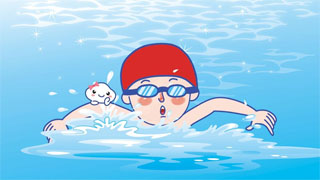
In recent years, more and more people have fallen in love with swimming, but due to various improper reasons, there have also been more and more injuries among swimming enthusiasts. In this issue, we will talk about common injuries in swimming and how to effectively prevent and treat them to make swimming exercise more effective and scientific.
Knee joint injury in breaststroke
From the above table, it is not difficult to see that knee joint injury is one of the most common diseases in breaststroke, often seen in injuries to the medial collateral ligament of the knee joint. The main movement of breaststroke is the leg clamp, and frequent hip rotation and knee adduction can cause damage and pain to the inner side of the knee joint.
Causes of damage
When kicking in breaststroke, in order to align the inner side of the calf with the water, the kicking action must cause the knee and tibia to rotate outward, and the main function of the medial collateral ligament is to prevent knee joint eversion and tibia rotation. When the kick force is not appropriate, the medial collateral ligament cannot withstand this high-intensity work, causing injury.
Due to excessive local burden, such as single concentrated breaststroke teaching, high proportion of leg kicking training, or excessive training in the main breaststroke event, injuries caused by local fatigue.
Incorrect movement technique and unreasonable force. The calf kick direction of breaststroke is incorrect, and the kick lacks rhythm.
preventive measure
Strengthen lower limb strength training, especially by enhancing the strength of the adductor muscles. Before training, do sufficient preparation activities, such as practicing knee loops, squatting, and pressing legs on both sides. You can also massage your knees with your hands or rub them with water.
In breaststroke practice, you can alternate between paddling and kicking to practice. The training of breaststroke is important and appropriate. It is not advisable to overly focus on training a single leg kick to prevent damage caused by local fatigue.
After a knee injury occurs, training should be reduced or stopped, or swimming style should be changed, and training should be resumed after the injury has healed. In severe cases, seek medical attention.
Muscle and ligament strain
Some swimmers may experience swelling and pain in their joints after swimming activities, and feel powerless when exerting force, which may be due to muscle and ligament strains. The main cause of muscle and ligament strain is insufficient preparation for movement, resulting in injuries caused by rapid muscle contraction or excessive stretching during exercise. Swimming has high requirements for the waist and abdomen, especially butterfly swimming, which is not very friendly to people with lumbar disc herniation or weak waist and abdomen strength.
Reason for sprain: Insufficient preparation before exercise, engaging in high-intensity long-term swimming, which makes the muscles and ligaments unable to withstand the overload of swimming. Incorrect movements during swimming learning can also cause muscle and ligament strains.
Preventive measures: Before swimming, it is necessary to fully prepare for the exercise, especially for the shoulder, elbow, knee, and leg joints, until you feel warm. Strengthen joint flexibility exercises and muscle strength exercises, with correct movements and avoiding excessive force.
On site treatment: If there is partial or complete tear of the knee joint ligament, do not knead or massage the knee joint on the spot. The affected area should be immediately fixed and sent to the hospital for treatment.
Ear disease with functional impairment
Ear disease is an external auditory canal infection or otitis media caused by swimming activities. Its symptoms include redness, swelling, fever, severe pain, and in severe cases, pus and blood flowing from the ear canal. Those with otitis media may also experience symptoms such as headache, fever, nausea, and vomiting.
Causes of Ear Disease
Swimming pool water is not clean, bacteria invade the external auditory canal, or water enters the middle ear through the pharyngeal tube.
When swimming, if water is poured into the ear but not discharged in a timely manner, or if the outer ear is scratched with fingers or other objects, the eardrum may be damaged and perforated, allowing bacteria to directly invade the outer and middle ears.
Swimming when experiencing upper respiratory tract inflammation or catching a cold.
Preventive measures: Go swimming in a swimming pool or natural swimming pool with guaranteed water quality and strict disinfection treatment. Individuals with damaged or perforated eardrums should stop swimming. When swimming, pay attention to correct breathing and avoid choking on water. The most important thing is not to dig randomly after pouring water into the ear. You can use the jumping control method, that is, tilt your head towards the side of the water filled ear and use your feet on the same side to continuously shake and jump, so that water flows out of the ear. You can also tilt your head towards the water inlet ear, press your palm tightly against the earlobe of that ear, hold your breath, then quickly lift your palm, press and suck, and do it several times in a row to suck out the water.
Functional impairment of sinusitis
Sinus refers to the total cavity containing air in the skull and facial bones on both sides of the nasal cavity, named maxillary sinus, ethmoid sinus, frontal sinus, and sphenoid sinus according to the skull in which they are located. Because its opening is close to the nasal cavity, the mucosa of the sinuses is close to the nasal cavity. When swimming, if you choke on water, it may bring water into the sinuses. If the water quality is poor, it can cause inflammation. The symptoms include pain on both sides of the upper part of the nasal bridge, clear water flowing from the nose, and in severe cases, inflammatory secretions such as purulent nasal discharge.
Causes of sinusitis: The main cause of sinusitis is incorrect breathing during swimming, and bacteria introduced into the nose during flushing or choking can invade the nose, leading to weak body resistance and causing this disease.
Preventive measures: Master the correct method of breathing in water and avoid choking on water. If water enters the nasal cavity, do not pinch the nose forcefully, as this will squeeze water from the nasopharynx into the middle ear, causing otitis media. If sinusitis has occurred, follow the doctor's advice, seek treatment promptly, or apply a hot towel to the nose bridge after swimming to promote local blood circulation and help reduce inflammation.
Swimming conjunctivitis with functional impairment
Swimming conjunctivitis, medically known as "acute conjunctivitis", commonly known as red eye disease, is often caused by infection while swimming, hence it is called "swimming conjunctivitis". The symptoms include redness and itching of the eyes, persistent conjunctival congestion, and symptoms such as photophobia, tearing, and increased eye discharge.
Preventive measures: Strengthen the disinfection of pool water, and control the chlorine content in the pool water within the specified range. People with red eye disease are prohibited from swimming in the water and infecting others. Swimmers wearing goggles while swimming can prevent bacterial infections and protect their eyes from chlorine gas. After swimming ashore, it is best to apply chloramphenicol eye drops once or twice to prevent it.
abdominal pain
Sometimes there may be severe abdominal pain while swimming, usually similar to gastrointestinal spasms, and the painful area is around the navel; Like intestinal spasms, the painful area is in the lower left abdomen.
The cause of abdominal pain: eating too much or drinking too much water while swimming, eating difficult to digest food before going into the water. Due to catching a cold in the abdomen, stimulating intestinal roundworms, insufficient pre exercise preparation, and irregular breathing rhythm during swimming.
Preventive measures: Pay reasonable attention to food hygiene, swim one hour after meals, and be fully prepared for activities before entering the water. Pay attention to the rhythm of breathing when swimming.
On site handling: Pay attention to the swimming speed. If abdominal pain occurs in water, slow down the swimming speed. Pay attention to your breathing rhythm. Swim to the edge of the pool and immediately come ashore, then hold down the painful area with your hand and take a few deep breaths. The pain will alleviate or even disappear. If the pain continues or worsens, seek medical treatment.
That's all for the sharing about swimming. I believe everyone will gain something from reading here. The scorching summer is coming soon, let's play happily together!


